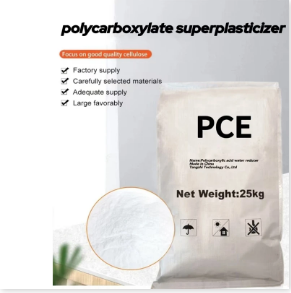
Polycarboxylate Admixture: High-Efficiency Solution For Modern Concrete
Polycarboxylate admixture is a new generation of high-efficiency concrete additive widely used in construction engineering. It is based on polyether macromolecules combined with carboxylic acid groups, which create both electrostatic repulsion and steric hindrance. This unique molecular structure enables polycarboxylate concrete admixture to improve concrete performance dramatically, surpassing traditional water reducer technologies in efficiency, dosage, and environmental friendliness.
Compared to conventional naphthalene or lignin-based water reducers, polycarboxylate admixture can reduce water consumption in concrete by 25% to 40%, significantly enhancing compressive strength, durability, and long-term workability. By uniformly dispersing cement particles, it prevents aggregation, maintains fluidity over time, delays setting, and improves construction efficiency.
The primary advantages of polycarboxylate concrete admixture include:
-
High Water Reduction Rate: Reduces water content up to 40%, improving strength and durability.
-
Low Dosage Requirement: Efficient even in small quantities, reducing production costs.
-
Environmental Friendliness: Low emissions during production and reduced cement usage, lowering concrete’s carbon footprint.
-
Enhanced Fluidity: Maintains workable concrete for longer periods, suitable for complex pours and pumping operations.
-
Improved Workability: Ensures easy placement, transport, and finishing of concrete.
Polycarboxylate concrete containing this admixture meets modern sustainable construction standards while delivering high-performance results in diverse applications.
Mechanism Of Polycarboxylate Admixture
Polycarboxylate admixture works through two main mechanisms:
-
Electrostatic Repulsion: The carboxylic acid groups create negative charges on cement particle surfaces, forcing particles apart.
-
Steric Hindrance: The long polyether chains prevent cement particles from re-aggregating, maintaining dispersion.
Together, these mechanisms ensure uniform distribution of cement particles, improving the fluidity, strength, and durability of polycarboxylate concrete. This also reduces segregation and bleeding, common issues in traditional concrete mixes.
Applications Of Polycarboxylate Concrete Admixture
Polycarboxylate concrete admixture is used in various types of concrete:
-
Ordinary Concrete: Improves fluidity and reduces water content.
-
Ready-Mixed Concrete: Enhances pumping and placement efficiency.
-
High-Strength Concrete: Provides high compressive strength and durability.
-
Precast Concrete Components: Shortens demoulding time, ensures dimensional accuracy, and improves surface finish.
In large-scale projects such as bridges, dams, high-rise buildings, and tunnels, polycarboxylate concrete ensures high performance, crack resistance, and extended service life.
Environmental Benefits Of Polycarboxylate Admixture
Using polycarboxylate concrete admixture offers multiple environmental advantages:
-
Reduced Cement Consumption: Less cement needed due to enhanced strength.
-
Lower Water Usage: Significant water savings compared to traditional mixes.
-
Reduced Carbon Footprint: Lower energy consumption and emissions during concrete production.
-
Sustainable Construction: Aligns with green building and modern environmental standards.
The combination of efficiency and eco-friendliness makes polycarboxylate admixture a cornerstone in sustainable concrete technology.
Performance Improvements In Polycarboxylate Concrete
The incorporation of polycarboxylate admixture enhances polycarboxylate concrete in the following ways:
-
Compressive Strength: Achieves higher strength at reduced water-cement ratios.
-
Durability: Improved resistance to cracking, shrinkage, and permeability.
-
Workability Retention: Fluidity maintained over extended periods for longer transport or placement.
-
Surface Finish: Smooth and uniform surfaces, especially in precast components.
-
Early Strength Development: Shorter construction cycles with faster strength gain.
In precast concrete production, polycarboxylate concrete admixture allows for:
-
Shorter Demoulding Times: Speeds up production cycles.
-
Dimensional Accuracy: Maintains precise measurements in molds.
-
Improved Surface Finish: Smooth and defect-free components.
-
Higher Efficiency: Increases throughput and reduces labor costs.
Precast panels, beams, and slabs benefit greatly from the consistent performance provided by polycarboxylate admixture.
Comparison With Traditional Water Reducers
Unlike traditional water reducers, such as naphthalene or lignin-based types, polycarboxylate admixture:
-
Reduces water usage more efficiently.
-
Requires lower dosage.
-
Maintains concrete fluidity longer.
-
Provides higher compressive strength and durability.
-
Aligns with green construction standards.
The combination of these advantages makes polycarboxylate concrete admixture the preferred choice for modern engineering projects.
The demand for polycarboxylate admixture is expected to rise due to:
-
Increasing use of high-performance concrete.
-
Emphasis on sustainable construction practices.
-
Growing infrastructure projects worldwide.
-
Government regulations promoting low-carbon materials.
As construction technology advances, polycarboxylate concrete will continue to demonstrate its irreplaceable value, especially in projects requiring high strength, durability, and environmental compliance.
FAQs About Polycarboxylate Concrete Admixture
What Is Polycarboxylate Admixture?
Polycarboxylate admixture is a high-efficiency concrete additive that improves workability, reduces water content, and enhances concrete strength and durability.
How Does Polycarboxylate Concrete Admixture Work?
It disperses cement particles using electrostatic repulsion and steric hindrance, maintaining fluidity and preventing particle aggregation.
What Are The Advantages Over Traditional Water Reducers?
Compared to conventional water reducers, polycarboxylate admixture provides higher water reduction rates, lower dosage, longer fluidity retention, and better environmental performance.
Where Is Polycarboxylate Concrete Commonly Used?
It is used in ordinary, ready-mixed, high-strength, and precast concrete, as well as large-scale engineering projects like bridges, dams, and high-rise buildings.
What Are The Environmental Benefits Of Polycarboxylate Admixture?
It reduces water and cement usage, lowers carbon emissions, and aligns with sustainable construction standards.
-
Hydroxypropyl Starch as a Sustainable Construction AdditiveNewsNov.24,2025
-
The Gelation Properties of CMCNewsNov.21,2025
-
Redispersible Latex Powder and Water Retention CapacityNewsNov.21,2025
-
Dosage Control for Polycarboxylate Water ReducerNewsNov.21,2025
-
Film-Forming Properties of Polyvinyl AlcoholNewsNov.21,2025
-
The Function of Gypsum Additives in MortarNewsNov.21,2025





















